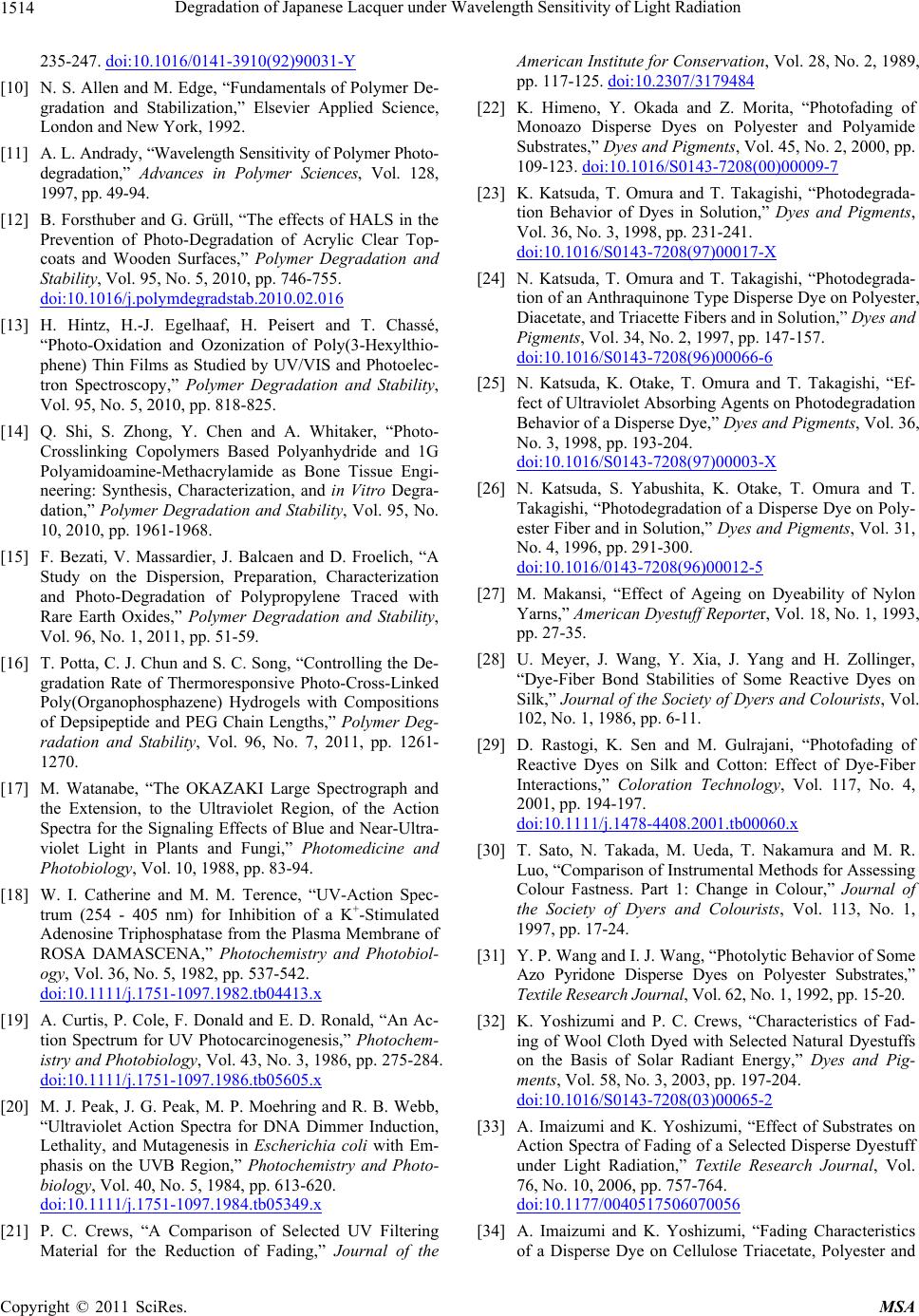
Degradation of Japanese Lacquer under Wavelength Sensitivity of Light Radiation
1514
235-247. doi:10.1016/0141-3910(92)90031-Y
[10] N. S. Allen and M. Edge, “Fundamentals of Polymer De-
gradation and Stabilization,” Elsevier Applied Science,
London and New York, 1992.
[11] A. L. Andrady, “Wavelength Sensitivity of Polymer Photo-
degradation,” Advances in Polymer Sciences, Vol. 128,
1997, pp. 49-94.
[12] B. Forsthuber and G. Grüll, “The effects of HALS in the
Prevention of Photo-Degradation of Acrylic Clear Top-
coats and Wooden Surfaces,” Polymer Degradation and
Stability, Vol. 95, No. 5, 2010, pp. 746-755.
doi:10.1016/j.polymdegradstab.2010.02.016
[13] H. Hintz, H.-J. Egelhaaf, H. Peisert and T. Chassé,
“Photo-Oxidation and Ozonization of Poly(3-Hexylthio-
phene) Thin Films as Studied by UV/VIS and Photoelec-
tron Spectroscopy,” Polymer Degradation and Stability,
Vol. 95, No. 5, 2010, pp. 818-825.
[14] Q. Shi, S. Zhong, Y. Chen and A. Whitaker, “Photo-
Crosslinking Copolymers Based Polyanhydride and 1G
Polyamidoamine-Methacrylamide as Bone Tissue Engi-
neering: Synthesis, Characterization, and in Vitro Degra-
dation,” Polymer Degradation and Stability, Vol. 95, No.
10, 2010, pp. 1961-1968.
[15] F. Bezati, V. Massardier, J. Balcaen and D. Froelich, “A
Study on the Dispersion, Preparation, Characterization
and Photo-Degradation of Polypropylene Traced with
Rare Earth Oxides,” Polymer Degradation and Stability,
Vol. 96, No. 1, 2011, pp. 51-59.
[16] T. Potta, C. J. Chun and S. C. Song, “Controlling the De-
gradation Rate of Thermoresponsive Photo-Cross-Linked
Poly(Organophosphazene) Hydrogels with Compositions
of Depsipeptide and PEG Chain Lengths,” Polymer Deg-
radation and Stability, Vol. 96, No. 7, 2011, pp. 1261-
1270.
[17] M. Watanabe, “The OKAZAKI Large Spectrograph and
the Extension, to the Ultraviolet Region, of the Action
Spectra for the Signaling Effects of Blue and Near-Ultra-
violet Light in Plants and Fungi,” Photomedicine and
Photobiology, Vol. 10, 1988, pp. 83-94.
[18] W. I. Catherine and M. M. Terence, “UV-Action Spec-
trum (254 - 405 nm) for Inhibition of a K+-Stimulated
Adenosine Triphosphatase from the Plasma Membrane of
ROSA DAMASCENA,” Photochemistry and Photobiol-
ogy, Vol. 36, No. 5, 1982, pp. 537-542.
doi:10.1111/j.1751-1097.1982.tb04413.x
[19] A. Curtis, P. Cole, F. Donald and E. D. Ronald, “An Ac-
tion Spectrum for UV Photocarcinogenesis,” Photochem-
istry and Photobiology, Vol. 43, No. 3, 1986, pp. 275-284.
doi:10.1111/j.1751-1097.1986.tb05605.x
[20] M. J. Peak, J. G. Peak, M. P. Moehring and R. B. Webb,
“Ultraviolet Action Spectra for DNA Dimmer Induction,
Lethality, and Mutagenesis in Escherichia coli with Em-
phasis on the UVB Region,” Photochemistry and Photo-
biology, Vol. 40, No. 5, 1984, pp. 613-620.
doi:10.1111/j.1751-1097.1984.tb05349.x
[21] P. C. Crews, “A Comparison of Selected UV Filtering
Material for the Reduction of Fading,” Journal of the
American Institute for Conservation, Vol. 28, No. 2, 1989,
pp. 117-125. doi:10.2307/3179484
[22] K. Himeno, Y. Okada and Z. Morita, “Photofading of
Monoazo Disperse Dyes on Polyester and Polyamide
Substrates,” Dyes and Pigments, Vol. 45, No. 2, 2000, pp.
109-123. doi:10.1016/S0143-7208(00)00009-7
[23] K. Katsuda, T. Omura and T. Takagishi, “Photodegrada-
tion Behavior of Dyes in Solution,” Dyes and Pigments,
Vol. 36, No. 3, 1998, pp. 231-241.
doi:10.1016/S0143-7208(97)00017-X
[24] N. Katsuda, T. Omura and T. Takagishi, “Photodegrada-
tion of an Anthraquinone Type Disperse Dye on Polyester,
Diacetate, and Triacette Fibers and in Solution,” Dyes and
Pigments, Vol. 34, No. 2, 1997, pp. 147-157.
doi:10.1016/S0143-7208(96)00066-6
[25] N. Katsuda, K. Otake, T. Omura and T. Takagishi, “Ef-
fect of Ultraviolet Absorbing Agents on Photodegradation
Behavior of a Disperse Dye,” Dyes and Pigments, Vol. 36,
No. 3, 1998, pp. 193-204.
doi:10.1016/S0143-7208(97)00003-X
[26] N. Katsuda, S. Yabushita, K. Otake, T. Omura and T.
Takagishi, “Photodegradation of a Disperse Dye on Poly-
ester Fiber and in Solution,” Dyes and Pigments, Vol. 31,
No. 4, 1996, pp. 291-300.
doi:10.1016/0143-7208(96)00012-5
[27] M. Makansi, “Effect of Ageing on Dyeability of Nylon
Yarns,” American Dyestuff Reporter, Vol. 18, No. 1, 1993,
pp. 27-35.
[28] U. Meyer, J. Wang, Y. Xia, J. Yang and H. Zollinger,
“Dye-Fiber Bond Stabilities of Some Reactive Dyes on
Silk,” Journal of the Society of Dyers and Colourists, Vol.
102, No. 1, 1986, pp. 6-11.
[29] D. Rastogi, K. Sen and M. Gulrajani, “Photofading of
Reactive Dyes on Silk and Cotton: Effect of Dye-Fiber
Interactions,” Coloration Technology, Vol. 117, No. 4,
2001, pp. 194-197.
doi:10.1111/j.1478-4408.2001.tb00060.x
[30] T. Sato, N. Takada, M. Ueda, T. Nakamura and M. R.
Luo, “Comparison of Instrumental Methods for Assessing
Colour Fastness. Part 1: Change in Colour,” Journal of
the Society of Dyers and Colourists, Vol. 113, No. 1,
1997, pp. 17-24.
[31] Y. P. Wang and I. J. Wang, “Photolytic Behavior of Some
Azo Pyridone Disperse Dyes on Polyester Substrates,”
Textile Research Journal, Vol. 62, No. 1, 1992, pp. 15-20.
[32] K. Yoshizumi and P. C. Crews, “Characteristics of Fad-
ing of Wool Cloth Dyed with Selected Natural Dyestuffs
on the Basis of Solar Radiant Energy,” Dyes and Pig-
ments, Vol. 58, No. 3, 2003, pp. 197-204.
doi:10.1016/S0143-7208(03)00065-2
[33] A. Imaizumi and K. Yoshizumi, “Effect of Substrates on
Action Spectra of Fading of a Selected Disperse Dyestuff
under Light Radiation,” Textile Research Journal, Vol.
76, No. 10, 2006, pp. 757-764.
doi:10.1177/0040517506070056
[34] A. Imaizumi and K. Yoshizumi, “Fading Characteristics
of a Disperse Dye on Cellulose Triacetate, Polyester and
Copyright © 2011 SciRes. MSA